WinCCS Automated Creep/Stress Rupture Testing
Applied Test Systems takes pride in introducing the SIGMA Testing System, an evolutionary system for Creep and Stress Rupture testing. SIGMA is a groundbreaking step for WinCCS plus first- and second-generation controllers, which have been used in significant testing environments for over thirty years. The SIGMA system maintains WinCCS as the control software, at the same time introducing the new third-generation SIGMA controller, together with new SIGMA testing machines. The SIGMA system is compatible with earlier controllers and data to safeguard the company’s investment in the current WinCCS systems.
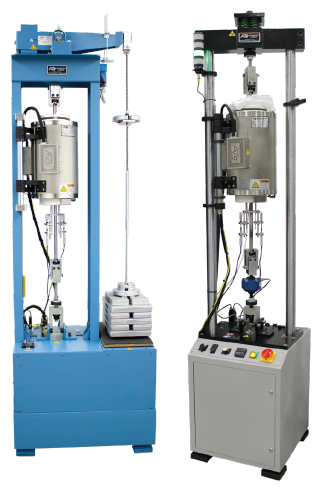
Sigma Machines Series 2320 & Series 2610. Image Credit: Applied Test Systems
Sigma Testing System Overview
The SIGMA Testing System is an automated system used to conduct stress rupture, creep, constant strain, and stress relaxation testing. The SIGMA test system comprises three components, the SIGMA test controller, the WinCCS SIGMA control software, and several test machines based on end-user requirements.
WinCCS SIGMA
The existing WinCCS is a Windows PC-based application that works on a computer placed in the user’s lab, which is interfaced straight into the test machines of the laboratory through communication cables. A library of testing methods employed for calibration and verification records, creep/stress rupture testing, and specimen data gathered at the time of tests are all kept within the control software. WinCCS prepares the reports and graphing, allowing the software to show the test data in several user-friendly formats. WinCCS enables complete testing that abides by ISO, ASTM, and turbine engine manufacturers’ specifications.
WinCCS SIGMA is an enhanced WinCCS, using a redesigned interface that improves the operator experience. WinCCS SIGMA introduces a new report characteristic that allows the user to produce WinCCS SIGMA reports as HTML documents.
An optional Laboratory Information Management System interface allows WinCCS SIGMA to communicate specimen test data and parameters with the current LIMS. WinCCS SIGMA is developed to work with all earlier versions.
SIGMA Controller
The SIGMA Controller, a microprocessor-based controller, controls specimen temperature, stress/strain, and measurement and collection of data of SIGMA Test Machines. After the WinCCS SIGMA control software begins the test, the SIGMA Controllers are independent and can conduct the test to completion with no more intervention from the host PC.
SIGMA Controller belongs to the third generation and captures the recent progress in hardware to attain highly accurate controls. The SIGMA Controller is an incredible leap in technology when compared to earlier generations with quicker processing, reading rates, and control loop response. SIGMA Controller provides a redesigned load control system that uses stepper motor control of the axial specimen load, offering a new grade of load control precision.
To complement the SIGMA Controller, an enhanced SIGMA user terminal has been introduced that has several new characteristics, including machine jog up/down buttons and an OLED high visibility display for seamless setup. The SIGMA terminal aids all earlier test machine controllers.
SIGMA Machines
SIGMA Machines implement an axial load to a specimen at a higher temperature. SIGMA quantifies and records the machine and specimen parameters for the test period. SIGMA Machines use a specimen furnace and an approach to produce the axial specimen load by automated load control or manually loaded fixed weights.
The SIGMA Machine is regulated through a microcomputer-based test controller that gets all the test parameters from WinCCS SIGMA and executes the test on the specimen.
With a capacity of 10,000 lbs in a lab space-saving package, a direct-loading model 2610 Test Machine is new for SIGMA. The 2610 Test Machine is completely automated and does not require weights.
Status Display Screen. Source: Applied Test Systems

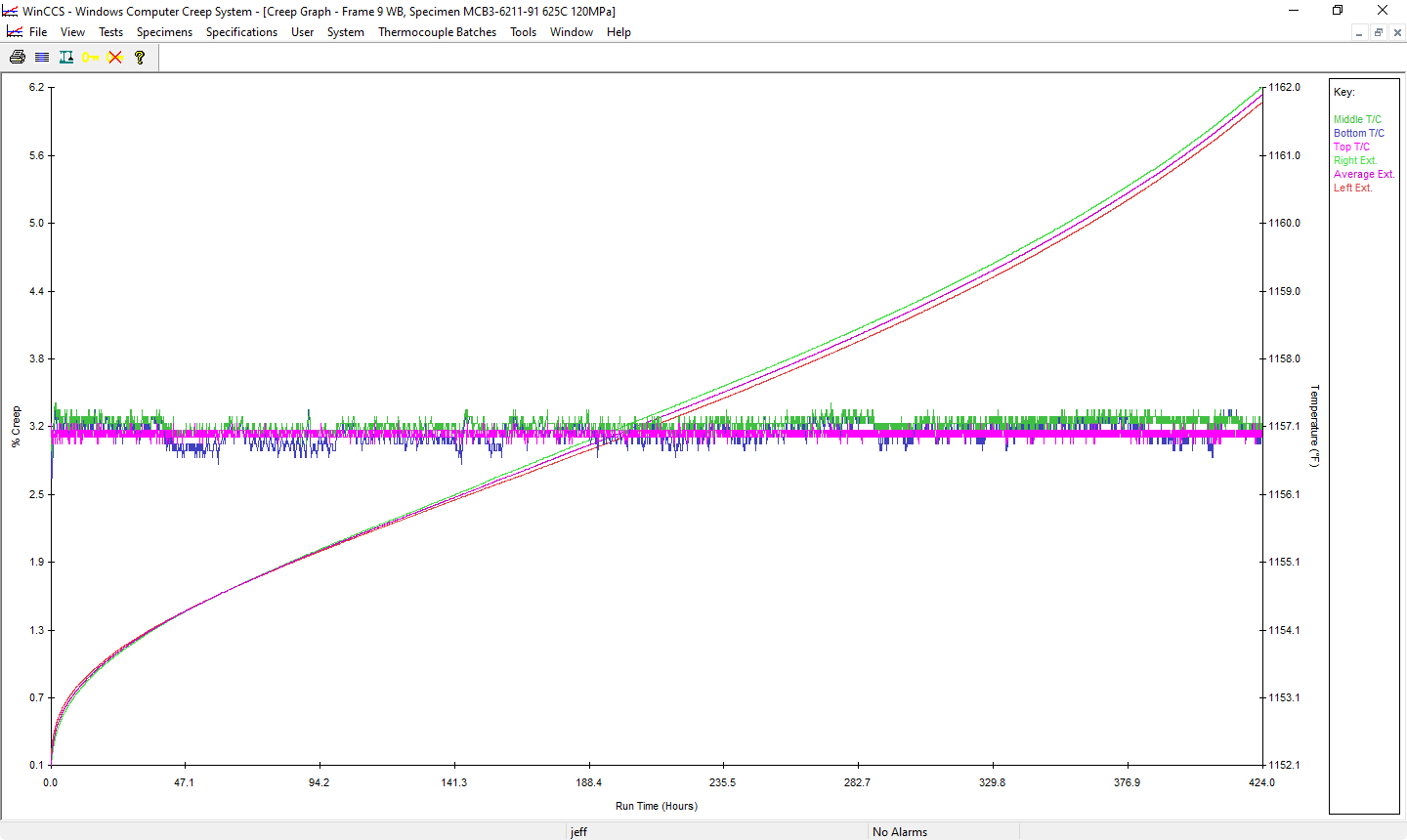
Creep Graph with Specimen Temperature (*actual test data). Image Credit: Applied Test Systems
Testers available with the Sigma Testing System. Source: Applied Test Systems
| |
2140-W3 |
2320-W3 |
2330-W3 |
2410-W3 |
2510-W3 |
2610-W3 |
| Max Force (Pounds) |
600 lb. |
10,000 lb. |
12,000 lb. |
20,000 lb. |
50,000 lb. |
10,000 lb. |
| Max Force (KN) |
2.67 KN |
44.5 KN |
53.4 KN |
89 KN |
222.4 KN |
44.5 KN |
Optional Enhancements
Digital Displacement Option
For creep and/or stress relaxation testing, this option can connect one or two Heidenhain displacement gauges to the system. It includes connectors, cabling, and software to combine the displacement gauges into the Test Machine.
Analog Displacement Option
This option can connect one or two LVDTs or other analog displacement measuring devices (for example, laser extensometers) to the system for creep testing. It comprises connectors, cabling, and software to combine the displacement gauges into the Test Machine.
Automatic Hot Step Load Option
This option uses specialized hardware and software to facilitate the SIGMA Test System to conduct automatic hot step loading a creep test with no operator intervention. It comprises a Load Cell with a special weight pan, electronic signal conditioning and adapters, and an extra lever arm counterweight to offset the weight of the load cell.
The operator stays responsible for loading the ultimate test weights onto the machine before the test start. The utmost load capacity for this option is the lesser of (i) the rated frame/lever arm capacity or (ii) the volume of the load cell multiplied by the lever arm ratio.
Load Control Option (Standard on SIGMA 2610 Test Machines)
This option offers weight-free specimen load control of the SIGMA Test Machine with no operator intervention. It is proposed for laboratories that perform a lot of load increases at the time of tests or short-span creep tests with automatic step loading. It comprises a Load Cell, special weight pan, Load Cell Adapters, frame attachment hardware, and an extra lever arm counterweight to offset the load cell’s weight.
The utmost load volume for this option is the lesser of (i) the rated frame/lever arm capacity or (ii) the volume of the load cell multiplied by the lever arm ratio.
Stress Relaxation Package
This option helps conduct Stress Relaxation Testing per ASTM E-328, Constant Strain Testing, and Constant Stress Testing.
Note: Needs the Load Control Option along with the Digital Displacement Option.
Cyclic Option
This option offers the capacity for the Test Machine cycle between preset specimen stresses, with operator-mentioned dwell times. The system collects higher-speed data during the increase and decrease load phases.
Note: Needs the Load Control option
WinCCS SIGMA Portable Display Module Option
This option displays specimen test parameters and jog control of the draw head or elevator. It is backward-compatible with every earlier version of WinCCS and can be utilized on several SIGMA Test Machines or past generations of WinCCS.

WinCCS Portable Display Module. Image Credit: Applied Test Systems

WinCCS Portable Display Module Main Screen. Image Credit: Applied Test Systems
Option Recommendations per Test Type. Source: Applied Test Systems
| Test Type |
Basic Tester with no options |
Load Control Option1 |
Automatic Hot Step Load Option2 |
Digital Displacement Option3 |
Analog Displacement Option3 |
Stress Relaxation Option |
Cyclic Load Option |
WinCCS Portable Display Module Option |
| Hydrogen Embrittlement F519 |
S |
O |
|
|
|
|
|
O |
| Stress Rupture |
S |
O |
|
|
|
|
|
O |
| Stress Rupture with Uploads |
S |
O |
|
|
|
|
|
O |
| Stress Rupture Combo |
S |
O |
|
|
|
|
|
O |
| Creep |
|
O |
|
R |
R |
|
|
R |
| Creep with Hot Step Loading |
|
O |
O |
R |
R |
|
|
R |
| Stress Relaxation |
|
R |
|
R |
|
R |
|
R |
| E328 Stress Relaxation |
|
R |
|
R |
|
R |
|
R |
| Constant Stress |
|
R |
|
R |
|
R |
|
R |
| Cyclic Loading |
|
R |
|
O |
O |
|
R |
O |
S: Standard O: Optional R: Required
1. Load Control is standard on Series 2610. System does not utilize weights
2. Requires Calibrated Weights
3. Select Digital or Analog
The novel SIGMA Testing System is yet another huge step ahead in Creep and Stress Rupture testing from Applied Test Systems. The new system includes control hardware, new machines, and WinCCS software.

Image Credit: Applied Test Systems
Gen 3 Hardware
Faster Microcomputer
Faster single-chip microcomputer that comes with inherent memory and program storage flash memory. The new processor is more than 100 times quicker than the GEN1/GEN2 processors. This enhances every aspect of the controller’s operation.
Advanced Speed Controls
Earlier systems came with the manual load speed potentiometer that is linked to an external motor controller. When starting a test, this resulted in several test issues where customers did not reset the manual potentiometer to return to the typical running position. The novel system has a direct input for the manual load speed potentiometer, therefore the software decides when to employ the input from it. This avoids any concerns with operator error.
Temperature and Humidity Sensor
A tester-mounted lab NIST traceable humidity and temperature monitor is automatically logged by the system using the test data. Users gain a constant record of the labs’ humidity and temperature implanted in their test data. This same sensor is employed to capture the ambient settings during verification and calibration procedures.
Improved Thermocouple Measurement
These new units also come with a more rapid thermocouple reading rate of 30 readings/minute versus the GEN1/GEN2 with one reading per minute. This considerably enhances furnace response post-transient events, like short-term power failures.
Cold Stepped Loading
Cold Stepped Creep loading has been included, allowing an operator to cold load the specimen at any point to load a report before a test is carried out. This enables the operator to examine the extensometer setup before beginning the test. This cold load might also be mentioned as part of the test as an advanced check of the extensometer setup.
Stepper Motor Drive
For more accurate load control and hot/cold stepped loading, new integrated Stepper Motor control is available. The novel stepper motor control is a big step forward in load control abilities that enable the same machine to tackle accurate load control and stress relaxation assessments.

Image Credit: Applied Test Systems
Improved Load Measurement
An improved load cell measurement system allows quicker load control adjustments.
Sampling Rate
Increased data sampling rates of 60/minute or once per second.
Super Capacitor
The new hardware employs a supercapacitor rather than a lithium battery for calendar clock backup. This implies that there is no need to replace batteries and no shipping restrictions on the actual hardware. By eliminating lithium batteries, the control boards can now be shipped anywhere, and spare boards do not have a battery shelf life.
Solid State Memory
Solid-state ferromagnetic FRAM is used for reading and test parameter memory rather than lithium battery backup RAM. In the event of a PC failure, this offers a better storage mechanism for readings. When the host computer is offline, this memory is utilized for reading storage.
Fault Display
Advanced diagnostics facilitating quicker troubleshooting is offered by digital onboard fault display.
32-bit Encoder I/F
A new 32-bit optical digital encoder measurement interface future-proofs the hardware for higher and/or longer-resolution optical digital encoders.
Analog Outputs
For high-temperature furnaces with analog power controls, analog outputs for furnace control are employed.
Light Bar
The style light bar shows the test and/or machine status from most locations across the lab.
Cyclic Stress Testing Option
At the time of the test, this option enables the user to mention cyclic unloading of the specimen. This can be specified for the complete test or a particular number of cycles. This option, integrated with the SIGMA controller, enables increased speed data acquisition at the actual loading and unloading of the specimen so that a precise profile of the specimen load can be graphed.
Stress Relaxation Option
Conducts Constant Stress, Constant Strain, or Constant Strain per ASTM E328. The new SIGMA Controller, using its increased data acquisition, speed computing, and stepper load train control, facilitates accurate controls in stress and strain mode, which were previously unachievable.
Gen 3 Portable Display
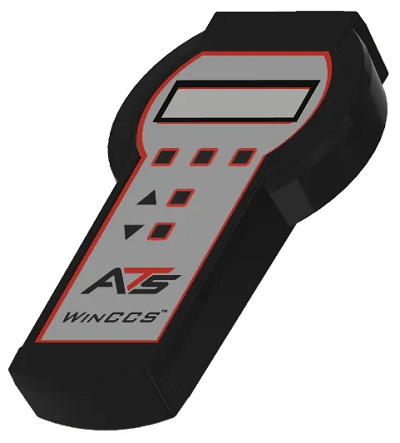
Image Credit: Applied Test Systems
OLED Display
High-resolution OLED display increases visibility in all lighting settings.
Jog Controls
Machine Jog Controls that come with indicator LEDs.
Faster Microcomputer
Faster processor for more streamlined display operation.
Backwards Compatible
Functions with GEN2 and GEN3 controllers.
Languages
Many language fonts are directly supported.
Version 8 WinCCS
Optional LIMS Integration
An optional Laboratory Information Management System (LIMS) integration feature has been added to the WinCCS system. This enables a LIMS system of the customer to import specimens, specimen measurements, test specifications, thermocouple batch information, etc., to the WinCCS system and export entire assessment records to the LIMS. All of the data exchange is through XML data files to simplify implementation. The LIMS integration also aids the bar code scanning of specimen bags to minimize errors.
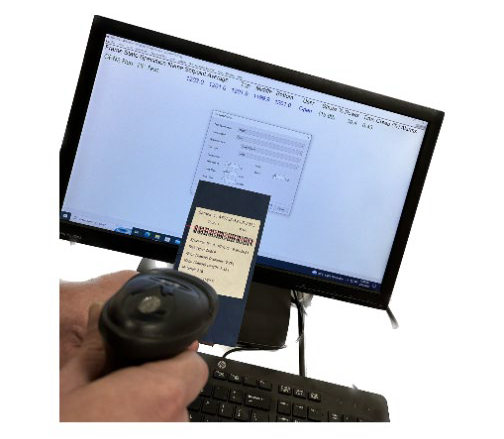
Image Credit: Applied Test Systems
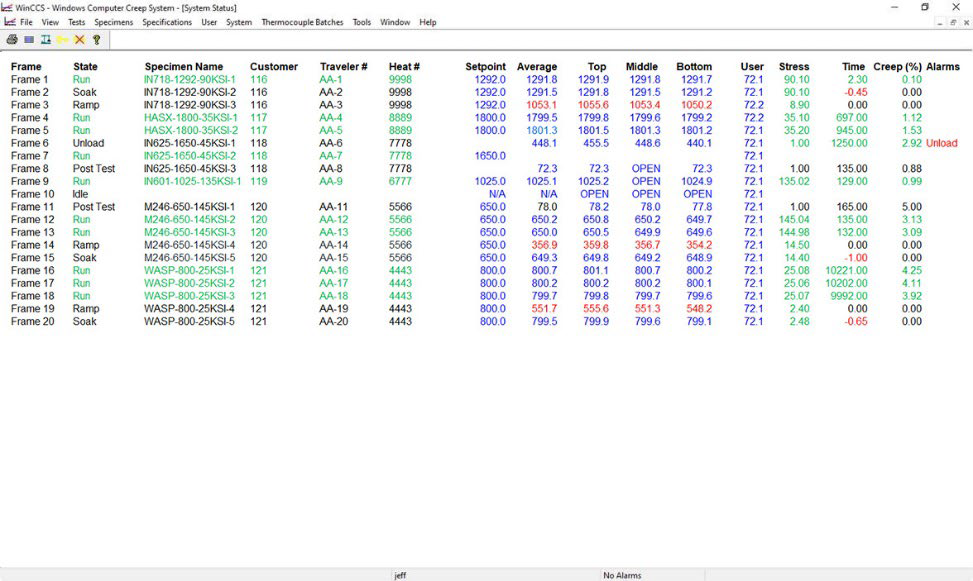
Image Credit: Applied Test Systems
HTML Reports
HTML Reports facilitate seamless report export to clients. HTML formatting is a renowned document standard, enabling the reports to be seamlessly emailed and seen in a web browser.
Status Display
A new system status display with context-sensitive menus facilitates quicker navigation to control functions with the testing machine.
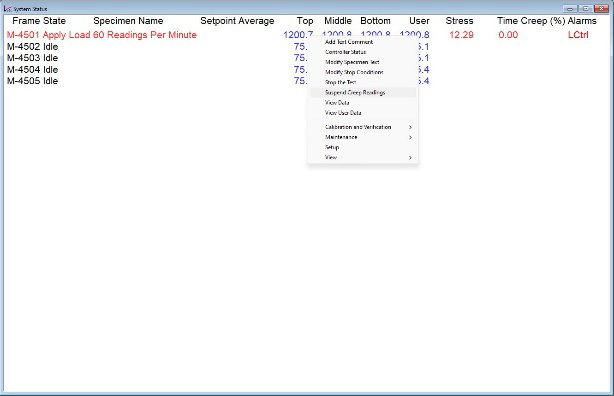
Image Credit: Applied Test Systems

Image Credit: Applied Test Systems
Furnace Logging
New furnace logging routines with added parameters logged.
"Date","Avg Tmp","Ctrl T/C","S.P.","Rate","Err","Pwr","P Term","I Term","D Term","% STop","% SMid","% SBot","% Top","% Mid","% Bot","Top T/C","Mid T/C","Bot T/C","Wall T/C","ACV","Iso Tmp"
Running Test Modifications
Test termination parameters can be altered on a running test.
Creep Loading Validation
Extra checking has been included in the Hot and Cold Loading reports to programmatically find if a test might have binding issues or extensometer setup. After the test is hot stepped loaded, the system will assess the loading data, and if any issues are found, it will display the test frames data in red, signaling a concern and showing a “Hid” in the Alarms column. The test will pursue as usual, but this signals to the operator that this test should be analyzed to determine if it needs to be continued.
Elongation Methods
The 4D, 4W, 5D, 5W, and two custom elongation methods have been added.
Time Resolution
Time resolution from seconds to mS enables quicker SIGMA Hardware data acquisition rates.
Compatibility
Completely aids all earlier and existing WinCCS hardware.
Languages
New language support characteristics combine the language prompts into the code base, eventually avoiding the prompt file issues comprising version mismatches in the prompt files. The new language capacity also supports various languages. This same approach is also fed into the GEN3 hardware firmware avoiding the requirement for long prompt file downloads.
Setup
System setup improvements enable copying frame setups to simplify large system deployment.
Load Calibration and Verifications
Enhanced load calibration/verification routines that enable several runs as needed in ASTM E4.
Test Specifications
Increase the test specification editor to clarify discontinued tests' shutdown and pass-fail needs.
System Status
New system status file. The earlier versions wrote a system status file in CSV format each minute for external systems to utilize for reporting test status. Version 8 includes three kinds of system status files, as elaborated below:
Pre-Version 8 CSV Format:
Lab Number, Average Temperature, State, % Creep, Time in Hours
New CSV Format:
State, Average Temperature, % Creep, Load, Time in Hours, Top, Middle, Bottom, and User.
Version 8 XML Format
System Status:
The system status file lets user systems access the system status. Earlier versions had a simple CSV format with very minimal parameters. Version 8 enables the choice of the original, improved CSV or/and XML file. The XML file includes most data and should be utilized for new implementations.